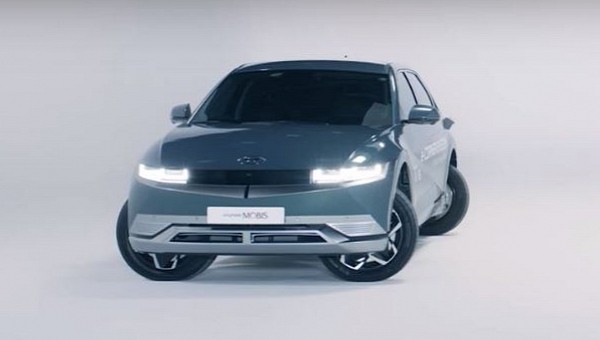Hyundai Mobis, the spare parts and autonomous driving division of Hyundai, has showcased a new version of its e-Corner modules at CES. The new prototype is based on an Ioniq 5, and it can crab walk. While the idea is a bit old, being first shown in 2018 by the same firm on a different prototype, it has now been installed on all four corners of a vehicle.
In theory, a vehicle that comes with four of these e-Corner Modules can turn in a narrow circle and parallel park like it's nobody's business. The system is also capable of driving in a diagonal, just like Hummer's new crab walk feature.
According to its creators, the module in question is a complete package per wheel, and it contains an electric motor, a damper, brake-by-wire, and steer-by-wire systems.
What is not mentioned anywhere is the weight of such a module. Since it is installed inside the wheel, it will be unsprung weight, so it might affect handling even in a heavy EV.
While a prototype based on a Hyundai Ioniq 5 was shown with the new technology, it is fair to say that Hyundai Mobis has no plan of releasing such a system as an optional feature anytime soon. It is unclear if it will ever make production, as it solves some problems by adding more complexity, and the latter part involves costs.
As you may be aware, an EV is not exactly cheap these days, and installing four additional in-wheel modules with motors, as well as modifying the steering and braking systems for them will generate costs that most people are not comfortable paying extra for. Sure, it eliminates the conventional motors and provides cool torque vectoring, but at what cost? Weight, unsprung mass, and more complexity. Who is willing to pay for this?
That last bit is exactly what automakers are looking for whenever they approve new functions. Rarely, one or several outlandish features slip through the seams, and they end up costing more than consumers pay for them.
Sure, it makes for a great party trick, but what we know today about adding such a complex system to a production vehicle leads us to believe it might not happen too soon or at a reasonable price. Getting it exactly right might be the tricky bit, but not all the things that you see at the Consumer Electronics Show become products that people can go out and buy.
The same logic applies to concept vehicles, which are designed to highlight the styling direction chosen by an automaker for the next few years, but few of those concepts transform into 1:1 production vehicles.
In the case of concept vehicles with a particular design, the latter may prevail and end up being manufactured thanks to favorable public opinion, but that does not guarantee success on the market.
It is important to note that systems like these were first shown (in a more rudimentary form) almost 100 years ago, and they involved a vehicle that had a fifth wheel that could be lowered to raise the rear end and allow for quicker turnaround maneuvers, as well as easier parking in tight spaces.
It did not catch on because of its complexity and cost, as well as the fact that The Great Depression had just become a thing.
According to its creators, the module in question is a complete package per wheel, and it contains an electric motor, a damper, brake-by-wire, and steer-by-wire systems.
What is not mentioned anywhere is the weight of such a module. Since it is installed inside the wheel, it will be unsprung weight, so it might affect handling even in a heavy EV.
While a prototype based on a Hyundai Ioniq 5 was shown with the new technology, it is fair to say that Hyundai Mobis has no plan of releasing such a system as an optional feature anytime soon. It is unclear if it will ever make production, as it solves some problems by adding more complexity, and the latter part involves costs.
As you may be aware, an EV is not exactly cheap these days, and installing four additional in-wheel modules with motors, as well as modifying the steering and braking systems for them will generate costs that most people are not comfortable paying extra for. Sure, it eliminates the conventional motors and provides cool torque vectoring, but at what cost? Weight, unsprung mass, and more complexity. Who is willing to pay for this?
That last bit is exactly what automakers are looking for whenever they approve new functions. Rarely, one or several outlandish features slip through the seams, and they end up costing more than consumers pay for them.
Sure, it makes for a great party trick, but what we know today about adding such a complex system to a production vehicle leads us to believe it might not happen too soon or at a reasonable price. Getting it exactly right might be the tricky bit, but not all the things that you see at the Consumer Electronics Show become products that people can go out and buy.
The same logic applies to concept vehicles, which are designed to highlight the styling direction chosen by an automaker for the next few years, but few of those concepts transform into 1:1 production vehicles.
In the case of concept vehicles with a particular design, the latter may prevail and end up being manufactured thanks to favorable public opinion, but that does not guarantee success on the market.
It is important to note that systems like these were first shown (in a more rudimentary form) almost 100 years ago, and they involved a vehicle that had a fifth wheel that could be lowered to raise the rear end and allow for quicker turnaround maneuvers, as well as easier parking in tight spaces.
It did not catch on because of its complexity and cost, as well as the fact that The Great Depression had just become a thing.










